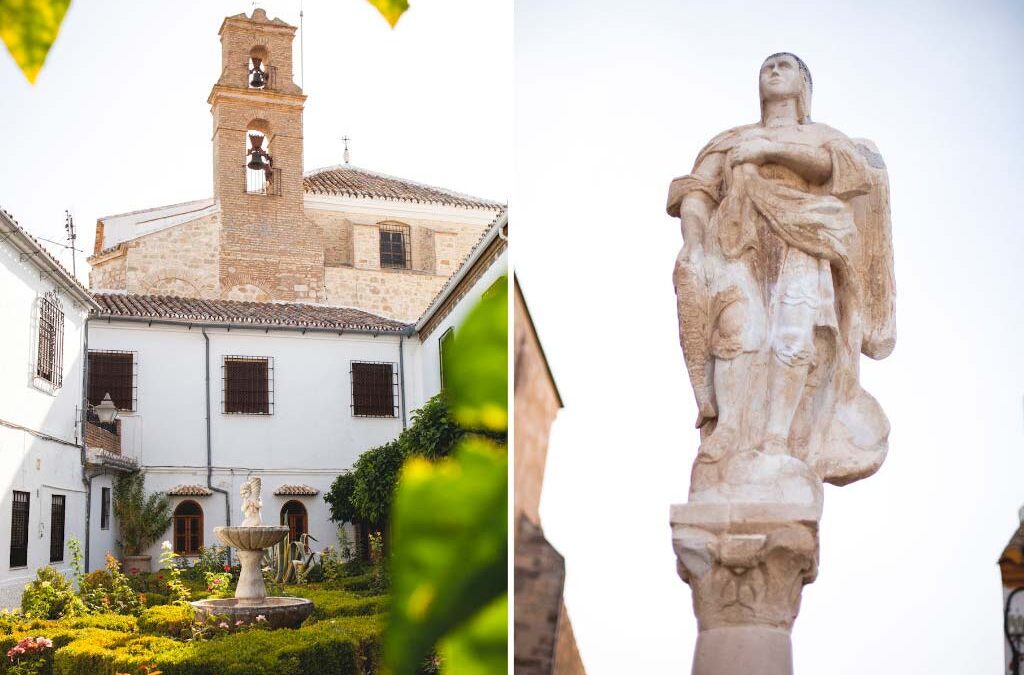GETAWAY Welove…
Baena – Castro del Río – Luque – Montilla
Text: Rosa Marqués @rocamarca | Traslation: Cristina Hodgson @cristinahodgson | Photography: Javier Portero @estudio.casa.palop | Main picture: In Baena you can find silent corners like this one, the convent of the Madre de Dios (1510) and small squares overlooking the Cordovan countryside, with sculptures similar to this watchful angel. All this in the almedina.
Reading time: 8 minutes
Our base is in the town of Baena, where we enjoy a leisurely stroll around the almedina. In nearby Luque, we savour the exquisite cuisine prepared by a disciple of a three star Michelin chef. In Castro del Rio we are captivated by a contemporary museum inside a former chapel, and in Montilla, we visit the oldest winery in Andalucia.
The “school year” has just begun and we are already tired of the daily grind: transport, work, uncertainties… “Why do we still live in this city”, my friends and I often ask ourselves when we meet. And while we may or may not take the final step out of this urban jungle called Madrid, this year we have decided that from time to time we will escape and recharge our batteries, to some charming little town that provides us with the ingredients we are looking for. Do you know which village we have chosen? Baena.
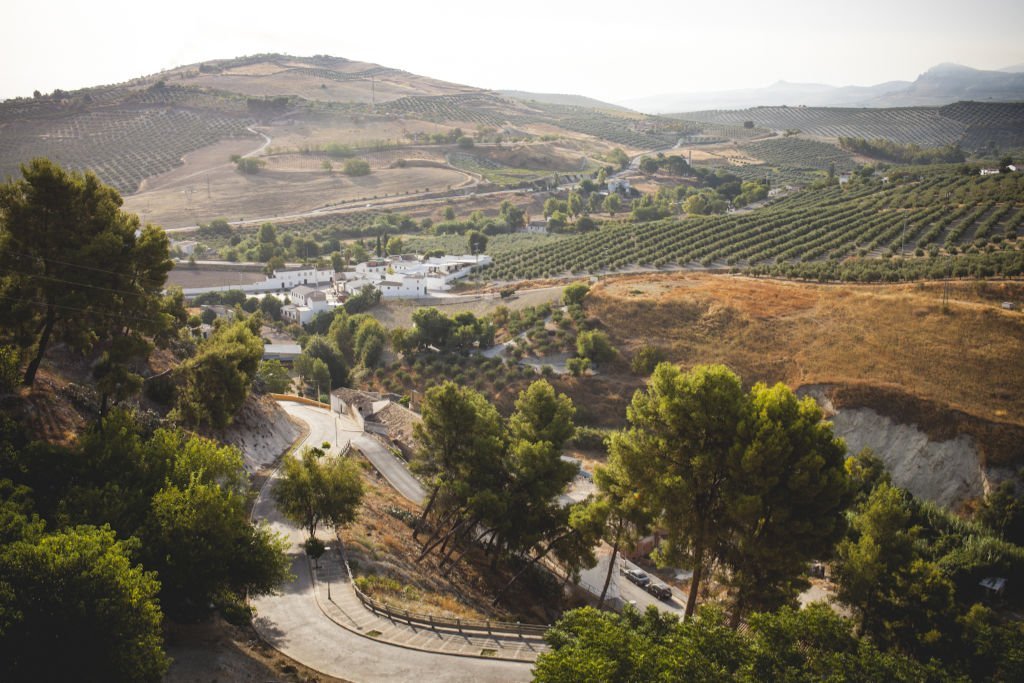
Baena is located right on the border between the Sierra Subbética and the Cordoba countryside: oil and wine in equal parts.
We found this Cordovan town to be the perfect base for everything we wanted to do. Baena really has it all: excellent cuisine based on its spectacular extra virgin olive oil – with a fabulous restaurant just a stone’s throw away (we’ll tell you more about that below); wonderful accommodation with views of the Sierra Subbética (the town is on the border between the Cordoba countryside and the Sierras Subbéticas)… And ah! what a terrace at our accommodation, it won us over us from the start (more details once again below)… from which we organised our own night-time barbecue, accompanied by our favourite local wines, from Montilla-Moriles, whose wine cellar we also visited. And of course, all this interwoven with shared confidentialities under the stars. A grand plan for friends, don’t you agree?
Such a setting allowed us this and much more, because besides moving between vineyards and olive groves far from the madding crowd, breathing fresh air and slowly immersing ourselves into the wine and oil culture, we met interesting artisans. So, are you in?
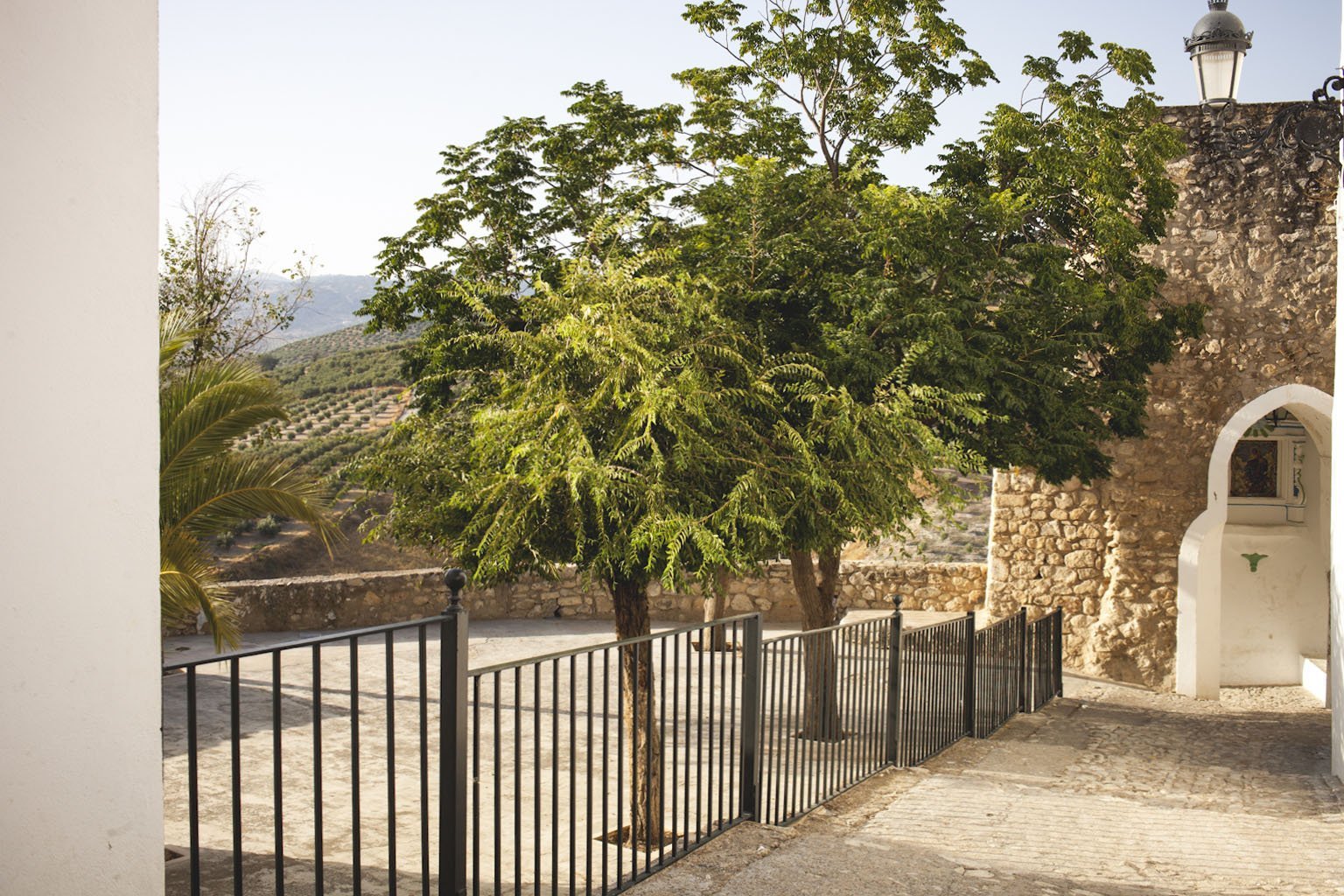
El Arco de Consolación was the gateway to the Arab wall of Baena, simply a magical place to be.
FRIDAY AFTERNOON
Baena is one of those villages that makes you fall in love at first sight. You don’t expect it to be as plentiful as it is of romantic viewpoints, inviting you to gaze into the horizon and unwind as you take in the setting sun, the sound of birds a soft melody in your ears… People walk around unhur-riedly, greeting each other. For someone used to the frenetic rhythm of the city, these details are like balm to the soul.
The narrow streets of Baena’s Almedina all lead to the monumental Plaza Palacio. Undoubtedly the setting for numerous historical events and gatherings. A steadfast reminder, the renovated castle of Arabic origin, which dates back to the 9th century (890) and which had an enormous geostrategic value in the Christian conquest of Granada as it was on the border of both kingdoms.
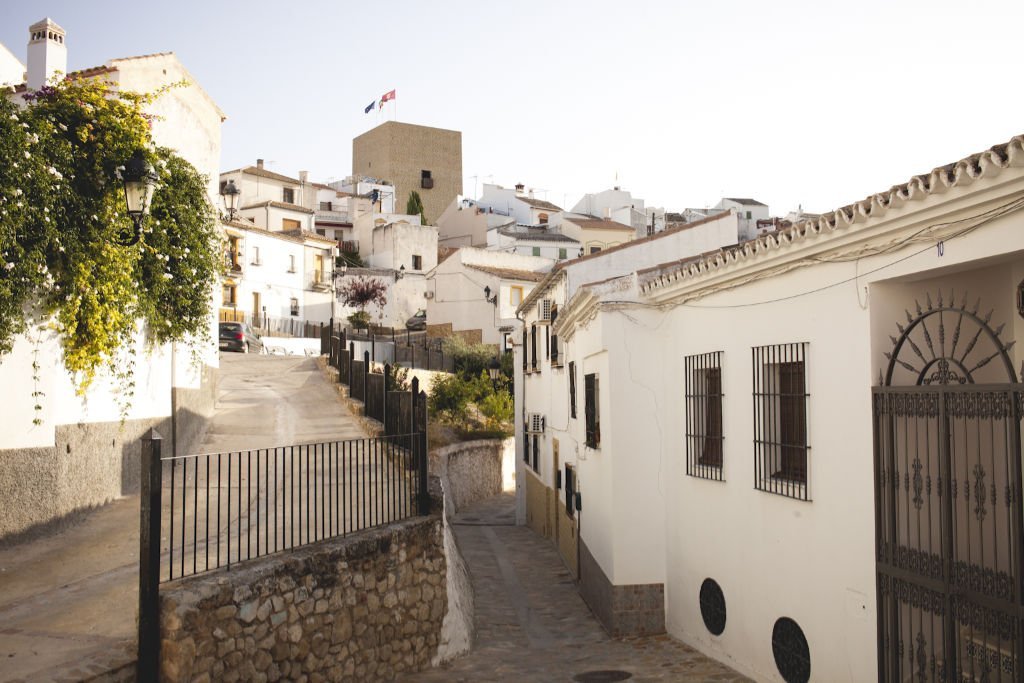
A lovely (if uphill) walk to the renovated Baena Castle, in the background.
As the parking area where we left the car is right next to this spectacular square, located in the high-est part of the town, dozens of possibilities suddenly unfolded before our eyes as soon as we ar-rived, confirming that we had made the right choice for our rural getaway. It was just what we were looking for. In this square, not only can you find the castle, but you can also view the outline of the so-called Cathedral of the Countryside, Santa María La Mayor and a representation of the Iberian Lioness made of limestone from the 6th century BC, found in the archaeological site Cerro del Min-guillar – Baena is surrounded by very interesting archaeological sites such as Torreparedones-. The original Leona íbera (roaring) is in the Archaeological Museum of Madrid -in the Baena Museum you will find a replica- to give you an insight of the historical value of the land you’re standing on.
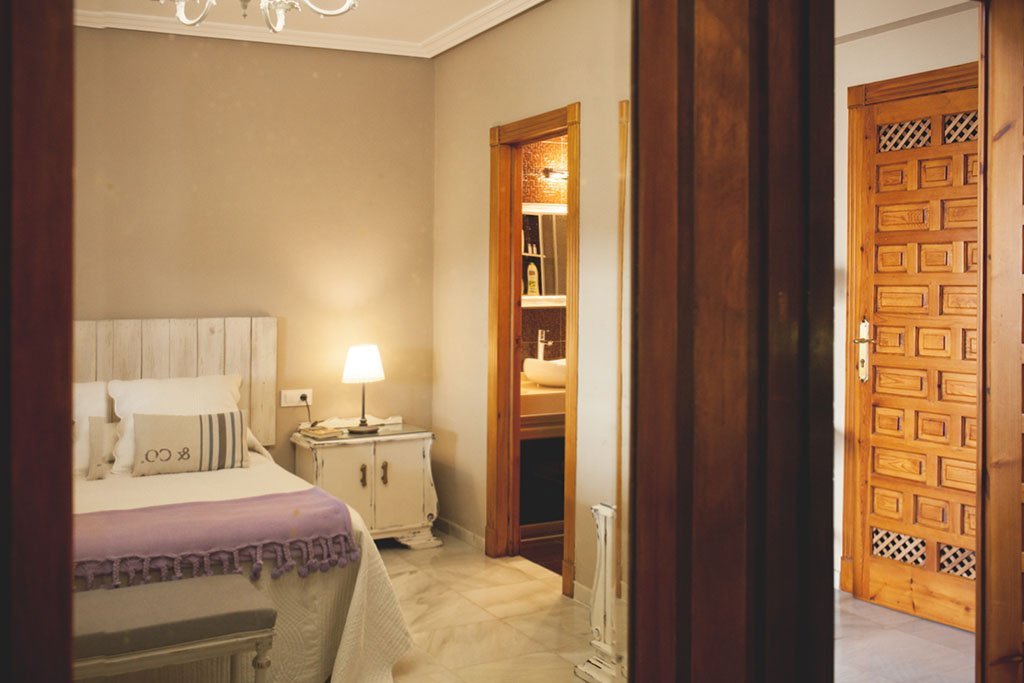
In the Torreón de Morayma, its eight rooms have a contemporary style.
Acharming accommodation with terrace and views to the mountains.
Our enchanting accommodation also has its history. It is just a short walk from the car park and also looks out over the remains of what was once an Arab wall, to the Sierra Subbetica. The hotel’s name, Torreón de Morayma (the wife of the last Nazarite king) captivated us from the start, as did its atmospheric location. We all felt like Moraymas on reaching the entrance.
The buzz of the cicadas welcomed us, even in the heat of summer, humming background music for our arrival. Next to the door of our accommodation, our attention is caught by a small arch with a charming viewpoint. A magical place, half-hidden, known as the Arco de Consolación, (the perfect place for lovers) where, after leaving our bags in our rooms, we raised our glasses, with a Montilla-Moriles wine, in a toast “to us.”
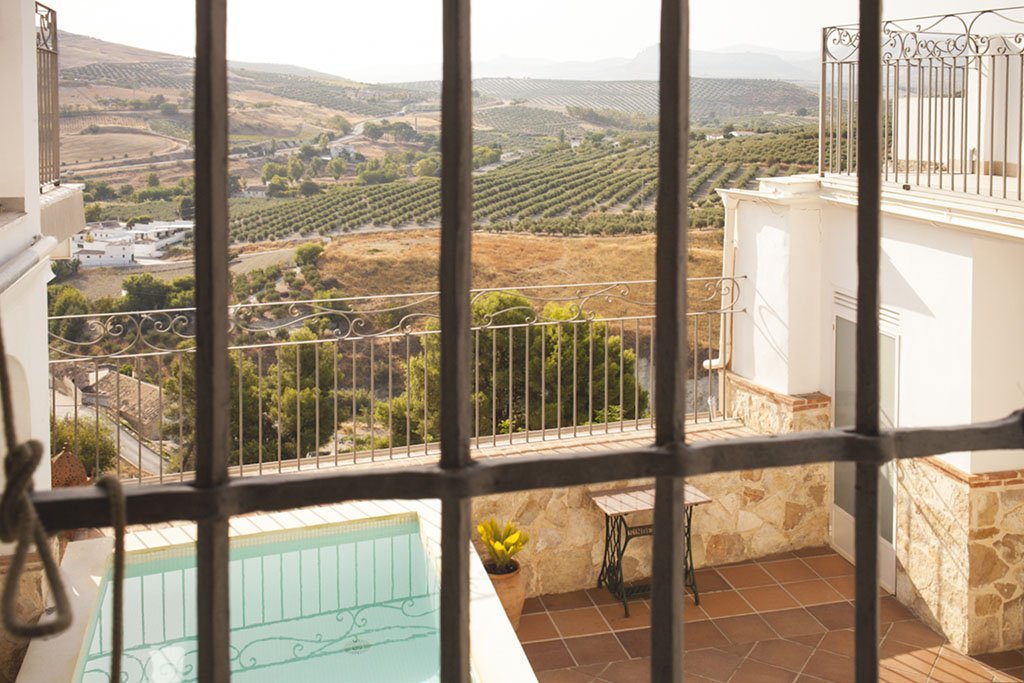
The swimming pool, available all year round, and the barbecue at the Torreón de Morayma are per-fect to help you unwind.
FRIDAY NIGHT
Dressed comfortably for the occasion. These villages, as we verified, all have sloped streets. In the Torreón de Morayma, we took our first profile pics, our favourite, the one taken from the small pool on the terrace, where we could cool off whilst gazing at the mountains: very instagrammable.
Then we went for tapas, to the central part of the village which, curiously, is down the sloped streets, away from the castle. The Town Hall square has several terraces perfect for a tapas dinner. Almost all the streets have views of the countryside, and in every corner there are tokens of the Ho-ly Week, such as the monument of the Jew with the drum: on those days practically the whole town goes out into the street, drum in hand, to make the sounds of the crowds of white-tailed and black-collar Jews, so called because of the tails hanging from their helmets.
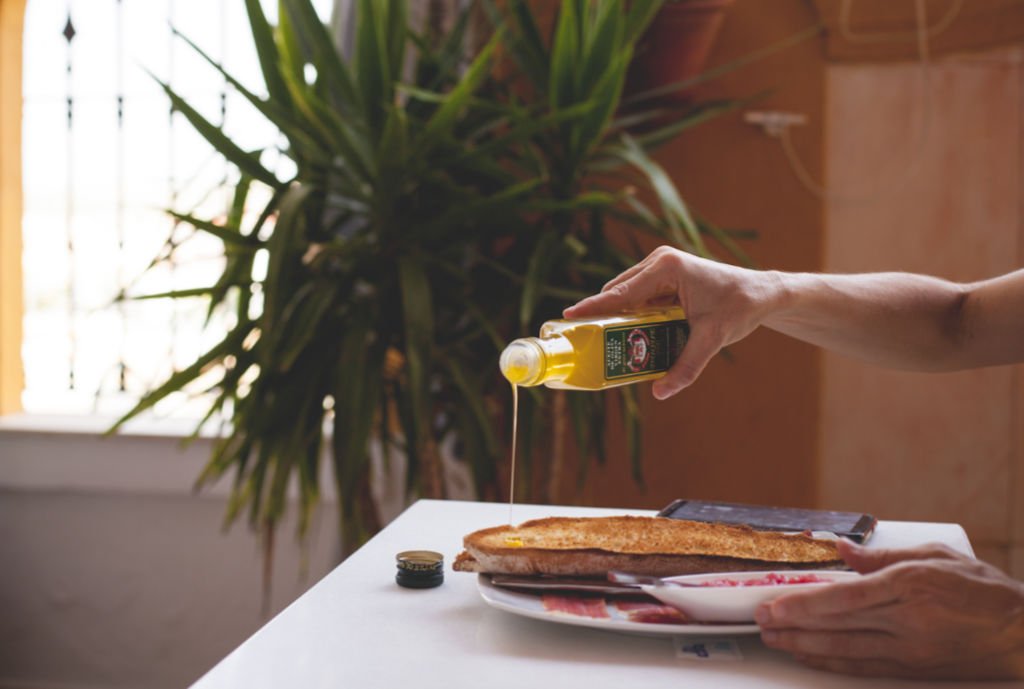
Breakfast, toast with extra virgin olive oil and tomato at the Casino de Baena, simply priceless.
SATURDAY MORNING
At 9.00 a.m. we had breakfast at the Casino de Baena, how could we not try a delicious toast with extra virgin olive oil, with typical country-style bread, tomato and orange juice! The Casino is ele-gant and pleasant, fresh, and the service is impeccable. Have breakfast or an apéritif – and yes, they also have Fino de Montilla-Moriles and tapas to go with it. Any preamble is a good excuse to learn more about the interesting Archaeological Museum of the city which is just a few metres away.
Then we chose one of the neighbouring towns to go for a walk and as one of our companions is an unconditional lover of olive wood, it turns out that just 15 minutes away by car is one of the most international artisan villas in olive woodwork: Castro del Río, and that’s where we went.
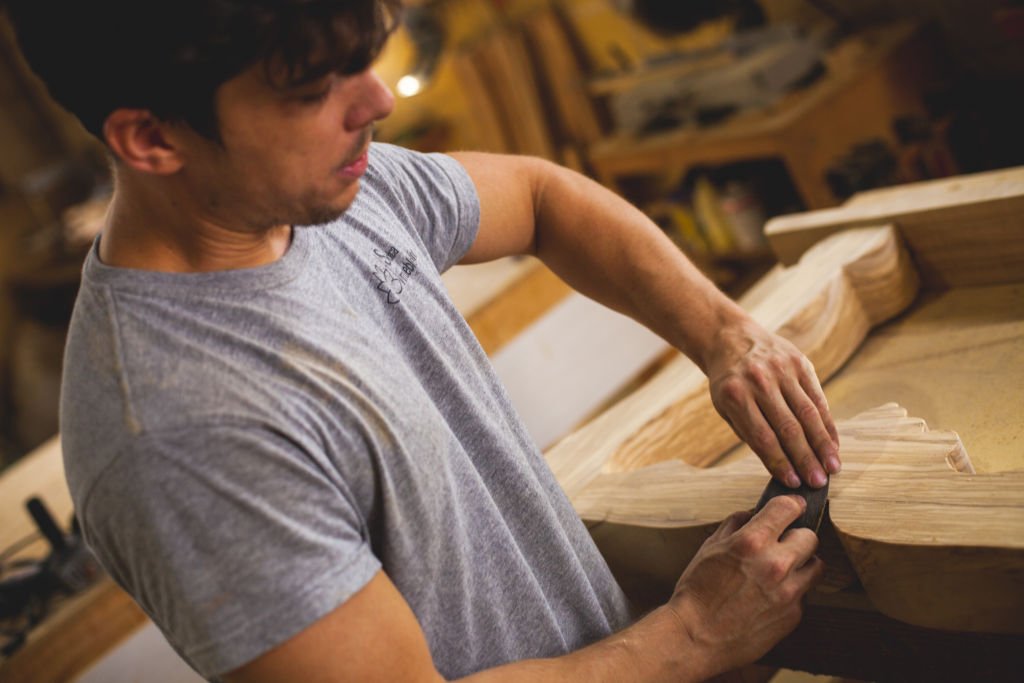
In Siolca, Benito, a young olive wood craftsman from Castro del Río, tells us all the secrets of olive wood.
Castro del Río, a refuge for craftsmen and artists
With less than 8,000 inhabitants, its lifestyle is delightfully rural and its craftsmen, perhaps because of the tranquillity that the trade requires, are of the highest level, well known throughout the area with growing international acclaim.
Castro del Río is one of the Areas of Artisan Interest of the Junta de Andalucía. In addition to the classic crafts made from olive wood: chairs, rocking chairs and all kinds of furniture that can last a hundred years, they are developing lines of work for boutique furnishing using olive wood, like large tables crafted from centenary olive trees, of two-and-a-half meters diameter each one -all with their certification of sustainable wood-. These elegant, impressive tables can be seen in some of the best hotels in the world. Especially now, when quality materials and olive wood in particular are in vogue.
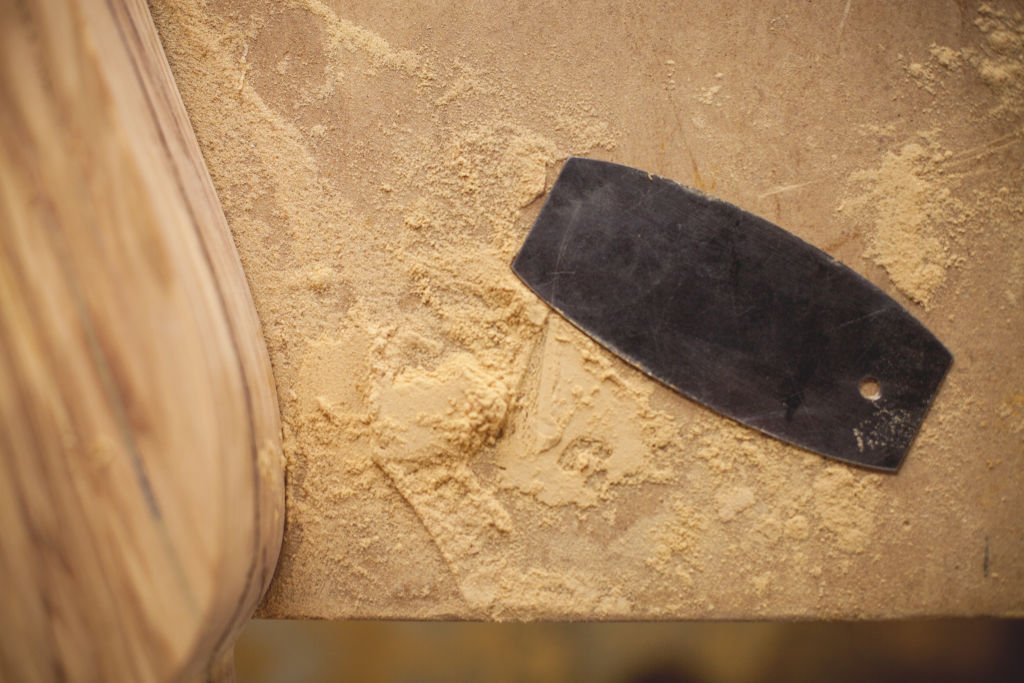
The woodwork in Castro del Rio is renowned worldwide. The very John F. Kennedy himself had two rocking chairs made there.
After visiting Siolca, where we were kindly attended by the only master craftsman in olive wood in the whole province of Cordoba, we set off for the centre of the town. After passing a picturesque arch, we come across Castro del Río’s town hall, a building which marks the boundary where the old city wall used to be. Where the royal butcher’s shops once were, with one of the nearby streets still aptly named Calle Carnicería, a place which was also the entrance to the old medina.
A contemporary museum inside a chapel
Next to the town hall, in an unsuspecting setting, surprise! We stumbled upon one of those places that would turn our adventure in Castro del Río into a truly memorable day. The Villatoro Museum is a hidden gem, the iron sculptures alone, located on the outside, entice you to enter. The grand entrance itself, with its remarkable frame, an indicator that there is something worth visiting inside. And it didn’t disappoint.
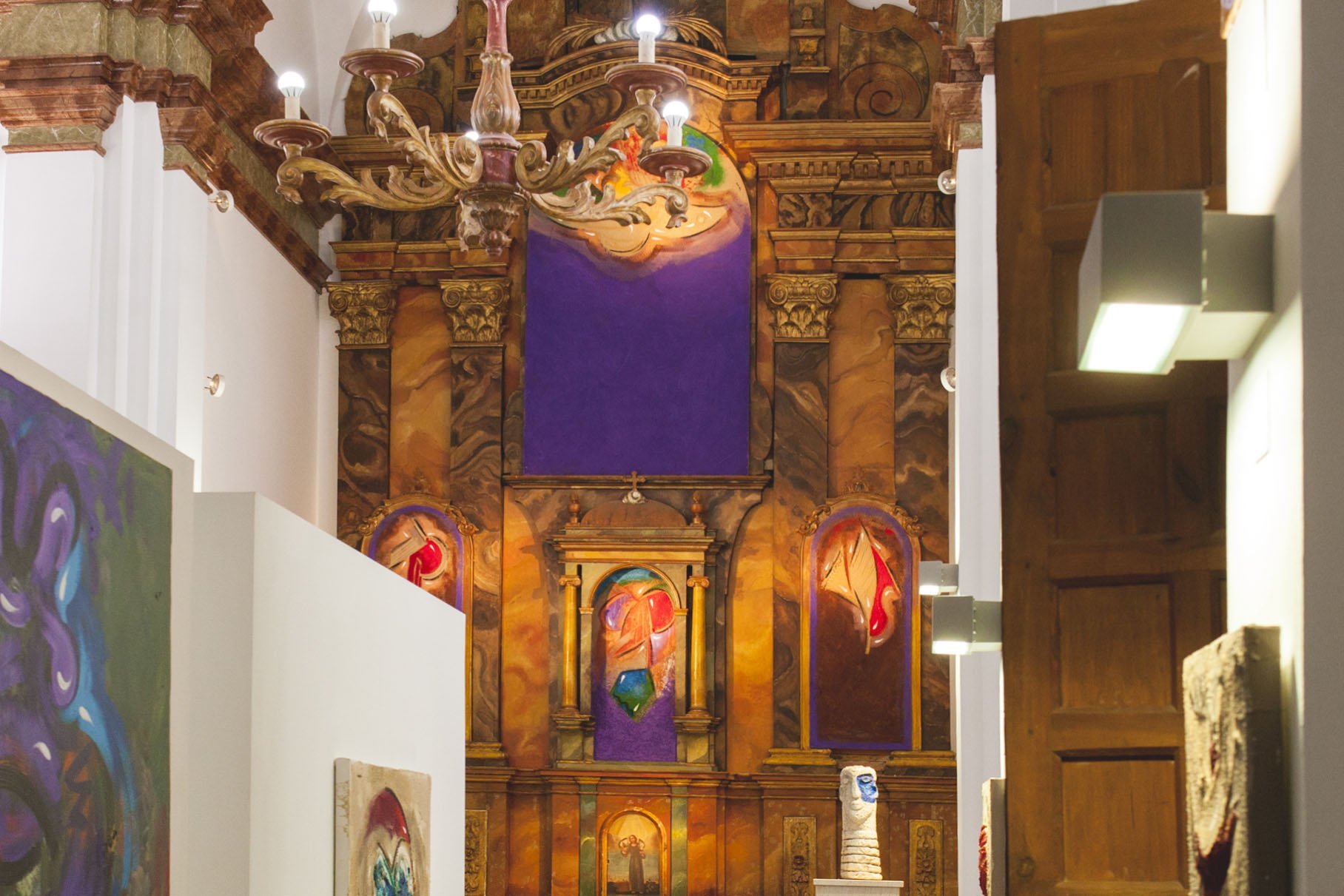
The Villatoro Museum exhibits an impressive collection by the multidisciplinary artist Antonio Villatoro inside a former chapel.
The temperature on the inside was noticeably cooler. The contrast inside created by the fusion of Contemporary Art in the chapel of this former church was, for us, unarguably beautiful and interesting. The artist of these works, which were given to the town council, is, as we were told, Antonio Villatoro, a well-known painter and musician from the town who currently lives in Madrid.
Antonio Villatoro could be considered a painter because of his links to the Movida Madrileña. He had a duo with Magnamara and has collaborated with Pedro Almodóvar in various works. Antonio Villatoro’s work is not to be missed and ranges from the most figurative to the most abstract. And in this small chapel, where he received mass as a child, it could not be more impressive. The journey through his work on display summarises two decades of his pictorial work.
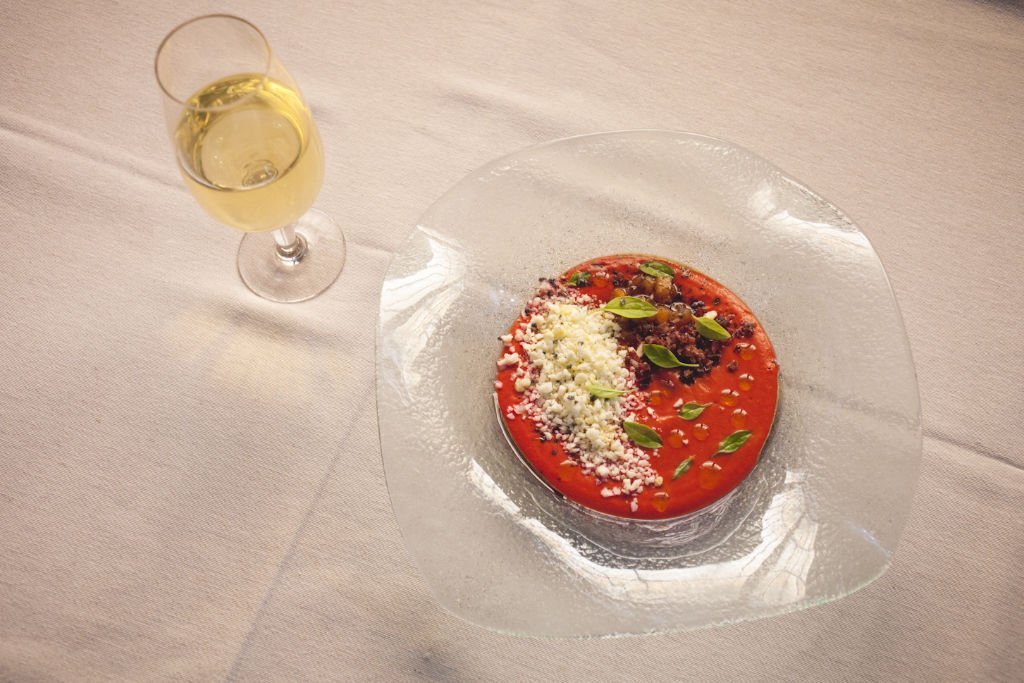
Whet your appetite with this beetroot Salmorejo with salmon tartare, grated goat’s cheese and jerky, accompanied by a Fino en Rama from the Nuestra Señora del Rosario Cooperative, in the El Olivo restaurant
LUNCH TIME
A praised tasting menu in a hidden place
As everything here is close by, for lunch we went to visit a restaurant that a local friend had told us about. Again, in the most unsuspecting of places. Hidden in the town of Luque, just a stone’s throw away from our accommodation, we went to enjoy the haute cuisine prepared by a disciple of chef Dani García, at a family-run restaurant, his parents’ restaurant, which he has already placed on the map. His tasting menu of between 10 and 14 dishes, at an unbeatable price, was perfect for us.
The restaurant, unsurprisingly called El Olivo, became from that moment on, another reference point, and the name of the star chef (take note): Francisco Barona Cañete, will never be forgotten. Its cuisine surprises and adapts to the tastes of each diner, and with it you can try the signature salmorejo as well as ceviche, tuna tartare, not to mention the oxtail cannelloni… Highly recommended.
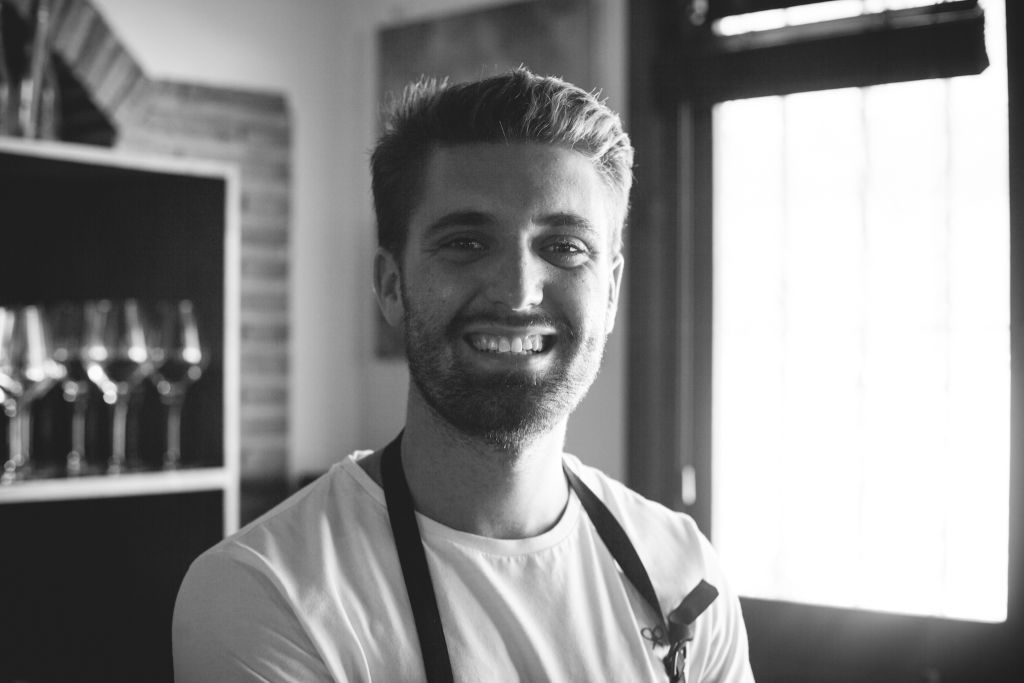
Francisco Barona Cañete, a disciple among others of the chef Dani García, is responsible for a tasting menu of 14 dishes at the El Olivo restaurant in Luque.
After a very long, leisurely after-lunch, as tradition dictates; and a few shots of Pedro Ximénez for dessert to end the succulent tasting menu, we returned to our cosy accommodation to rest for a while, take a bath and watch dusk settle over our particular paradise under a star-filled sky.
SUNDAY MORNING
We do not want to leave the area without making another stop along the way. Montilla is very close by, home to the oldest winery in Andalucia: Bodegas Alvear, a winery founded in 1729. The date says it all.
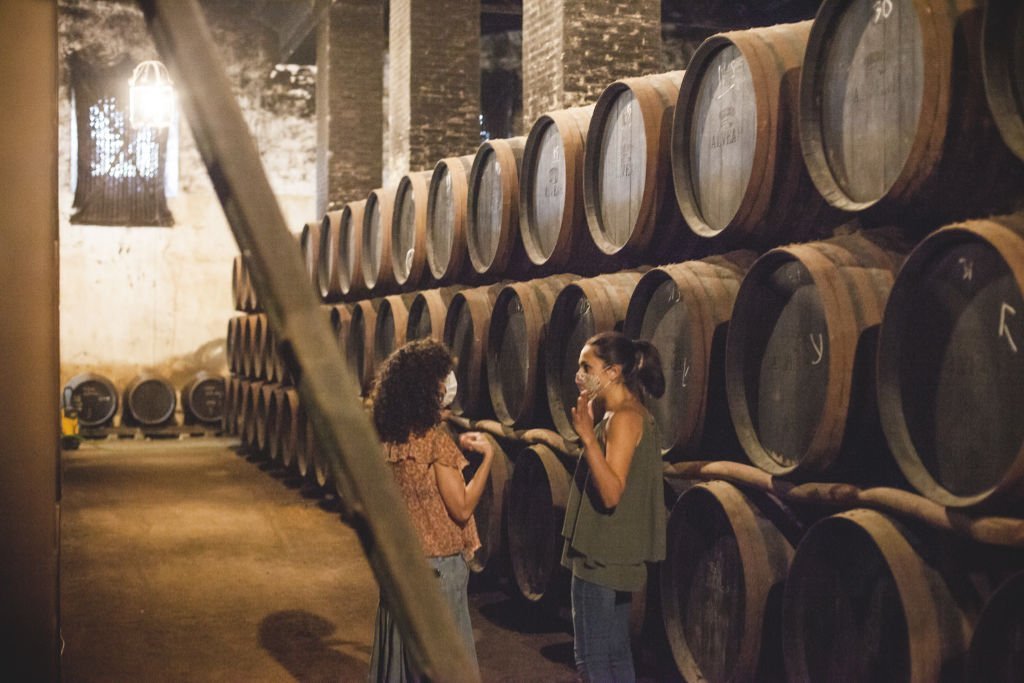
The visit to Bodegas Alvear leaves us with unforgettable moments. A walk among these old casks, among legendary wines, is highly recommended.
We took a walk through the different wineries, between “andanas” and “cachones”, terminology we learnt on site, whilst watching some corners of the winery being whitewashed, and we understood what the “solera system” is and aging “under a blanket of flor”, and we learned why one of our favourite wines of this winery is called the way it is: the 3 Miradas. (The 3 Gazes) The gaze out over the vineyard, the gaze over the winery and the gaze at the lagar. The winery also has soleras over two hundred years old.
This winery still belongs to the Alvear family, currently in the hands of the eighth generation. In the courtyards we also found old machinery: the first vertical presses that came to Montilla to press the pedro ximénez grape, which is used to make another of our favourite wines, the sweet Pedro Ximénez, a prized and award-winning wine which is recognised worldwide, obtained with overly ripe grapes of the same name which are dried in the sun and then pressed.
Before leaving for Madrid, we paused for one last breath of fresh air, a brief stop at the Cerro de Don Juan lookout, where let our gaze wander once more over the hills and gentle slopes of the area.
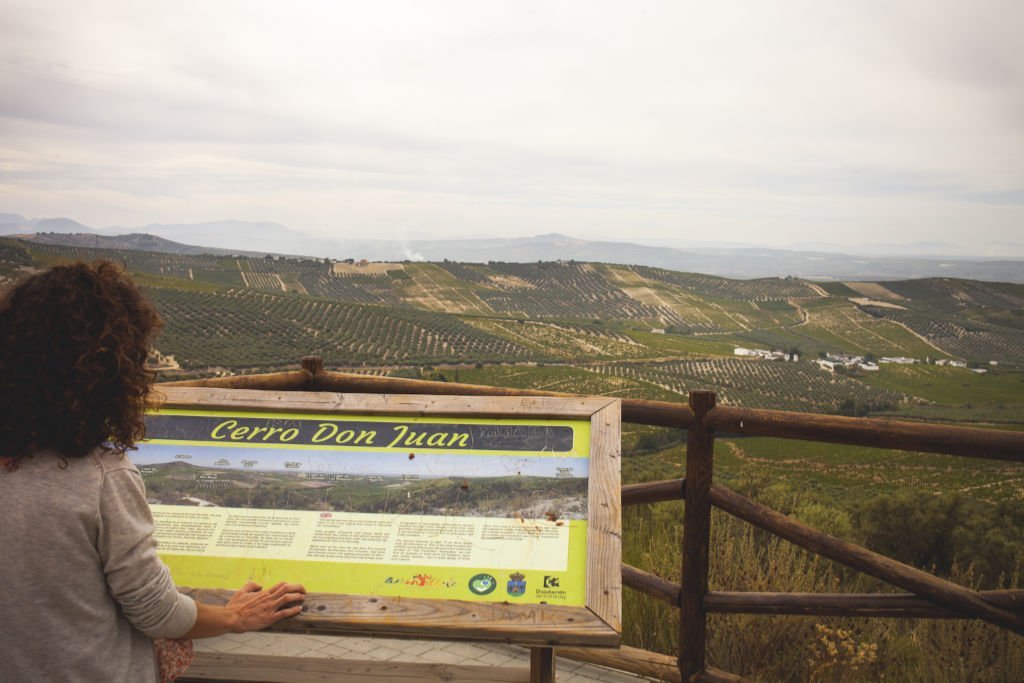
From Cerro de Don Juan, a viewpoint in the middle of the Sierra de Montilla, we saw some birds of prey and said goodbye to this spectacular landscape, until the next time.
USEFUL INFORMATION
HOW TO GET THERE:
From Córdoba to Baena it takes 55 minutes by car.
At the RENFE station in the capital, you can rent a car from €14/day if you do not have your own vehicle or if you are en route through andalucia.
WHERE TO STAY:
Torreón de Morayma. Calle Arco Consolación, 10, Baena; tel. 665 67 42 14.
This charming two-storey rural house with a capacity for 8 people can be hired out completely, at around €200 for the entire weekend (depending on the season), and a minimum of two days. In low season it is possible to rent for just one night. Because of its spectacular location, the towns of Zuheros and Luque, only 8 km away, can be seen from the terrace. It’s southeast orientation means that even in winter the sun warms the terrace, and if it gets too hot, it has a charming, small pool to cool down in.
WHAT TO SEE:
Baena Castle. Plaza Palacio, 4; tel. 957 67 17 57. Visiting hours: From Tuesday to Sunday, from 10.00 to 13.00. And from 16.30 to 19.30 on Thursdays, Fridays and Saturdays.
The castle is, according to Francisco Valverde y Perales, a Spanish writer from Baena, in his History of the Town of Baena, what sparked the town’s primitive population and “must have existed on high ground adjacent to that occupied by the present one”. In the 13th century it was conquered by Ferdinand III of Castile (called the Saint) and then in the 14th century it passed into the hands of the Fernández de Córdoba family, who later converted it into a palace, being one residence of the dukedom of the House of Cabra and later of Sessa and Baena. It remained in private hands until the end of the 19th century; and then, according to Diario Cordoba, it was sold at public auction and abandoned until 2005 when the city council commissioned the restoration of the monument to the architect José Manuel López Osorio. A restoration which receive the prestigious Architizer A+Awards in 2017, the year in which it was completed.
Baena Archaeological Museum. Calle del Beato Fray Domingo de Henares, 5; tel. 647 57 26 41.
The so-called Casa de la Tercia, where the museum is located, was once a grain and seed warehouse, an oil cellar and an inn, and even a prison during the Civil War. It was created as a result of the discovery of the Torreparedones site in the nineties. Most of its collections are from the Iberian and Roman periods. Several sculptures of lions and wolves have been found around ancient Iponuba, which experts say confirm the existence of a large workshop in this area, producing dozens of animal sculptures at the time and which are now of great archaeological value. Distributed to other museums as well, such as the Iberian Museum of Jaen, or the National Archaeological Museum.
Archaeological Park of Torreparedones. Road A-3125, TK 18, Baena; tel. 607 16 37 87.
This place was inhabited from the end of the Neolithic to the beginning of the 16th century, reaching its maximum splendour in the Iberian and Roman times, when it achieved the status of colony or municipality. The most relevant findings correspond to these periods.
Villatoro Museum. A former chapel of the Divina Pastora, next to the Castro del Río Town Hall; Calle Don Andrés J. Criado, 1; tel. 957 372 375. Free admission by appointment.
The museum of Antonio Villatoro, a multidisciplinary painter and artist, covers 20 years of his career mixing figurative and more abstract art in a rare setting as is this chapel, where his work is also displayed on the high altar. Trained in Fine Arts in Seville, he continued his studies in Madrid, London and Nairobi where he specialised in the primitive cultures that form part of his work and the faces he depicts.
Alvear Winery. Av. de María Auxiliadora, 1; tel. 957 652 939. Price of the visit, €12 (there are special prices for groups).
The standard tour of the oldest winery in Andalucia, and one of the oldest in Spain, includes a tasting of three of its wines. The tour lasts an hour and a half and includes a visit to the press, the fermentation room and the ageing cellars. Visiting hours are from Monday to Sunday by appointment, although Sundays and public holidays require a minimum number of visitors. From Monday to Saturday, the daily visits are at 12.30 in Spanish, pre-book for visits in English or French. The tour explains the history of the family, the variety of grapes, the Designation of Origin, the area of superior quality, the process of drying of the grapes under the hot sun, the ageing process of the wines, the fermentation, the ageing of the finos… The winery has an ageing capacity of 5 million litres in oak casks, distributed in different cellars: La Sacristía and El Liceo, are where the oldest wines are kept; Las Mercedes, better known as C. B; Las Higueras and Buganvillas, where the Pedro Ximénez wines are aged and the cellar called “de la Casa”, which is the first site used by Alvear and situated in the old town. This cellar, which is currently being renovated to offer quality tourist experiences in the future, dates back to the 18th century. Its cellar houses the oldest soleras in the area, amontillados with over 200 years of ageing. Other interesting experiences also offered at the winery include specialised tastings if the client requests as well as a visit to the bodega’s Lagar, Los Puentes, located in the sierra. A tour to Los Puentes takes you around the winery’s vineyards in an authentic 4×4 Land Rover owned by the winery.
WHERE TO EAT:
Baena Casino. Plaza de la Constitución, 5; tel. 957 67 01 48. Saturdays and Sundays from 10.00 to 2.00.
Dating back to 1913, this building with its elegant salons, quaint open air inner courtyard, is perfect for a hearty breakfast of toast with Baena D.O. virgin olive oil. It’s also perfect for tapas, or for an inexpensive daily lunch menu, starting at €5. They have Fino wine (not much variety) but enough to accompany a mid-day apéritif.
El Olivo Restaurant. Calle Cronista, Calle Vicente Estrada, 21, Luque; tel. 655 97 55 25. The restaurant is open every day except Tuesdays, for breakfast, lunch and dinner.
This informal restaurant serves a tasting menu of between 10 and 14 dishes in its interior room, prepared by the chef Francisco Barona Cañete, disciple of acclaimed chef Dani García. The tasting menu, which varies depending on the tastes of the customers and the season, is priced at €40, drinks are not included.

